Solution for Active and Passive Earth Pressure on Rigid Retaining Walls with Narrow Backfill
Abstract
1. Introduction
2. Theoretical Analysis
2.1. Active Limit Earth Pressure
2.2. Passive Limit Earth Pressure
2.3. Earth Pressure Distribution
3. Experimental Verification
3.1. Model Test
3.2. DEM Numerical Experiment
3.2.1. Parameter Selection
3.2.2. Active Limit Earth Pressure
3.2.3. Passive Limit Earth Pressure
4. Parametric Analysis
4.1. Effect of Various Parameters on the Active Limit State
4.2. Effect of Various Parameters on the Passive Limit State
5. Conclusions
- (1)
- Under the active limit state, the earth pressure resultant force behind the wall exhibits a parabolic relationship with the backfill width. For cohesionless soil, the earth pressure continuously increases until it reaches the Coulomb active earth pressure, while clay experiences an initial increase followed by a decrease in earth pressure.
- (2)
- For cohesionless soils with a smooth wall back, the passive earth pressure resultant force obtained by the proposed method fully coincides with the Coulomb’s solution within the critical width range, and the corresponding rupture angles equal to the Coulomb value. As the wall-soil friction angle increases, the influence of backfill width on the passive earth pressure becomes increasingly pronounced, while exhibiting distinct exponential decay characteristics with increasing backfill dimensions.
- (3)
- Upon reaching the critical width, the approach presented in this paper can be simplified to the Coulomb theory for cohesionless soil. For clay, the results obtained in this paper are higher than those predicted by the Coulomb theory under an active state while being slightly lower under a passive state.
- (4)
- For a given backfill width, the cohesion is inversely proportional to the resultant active limit earth pressure force and directly proportional to the resultant passive limit earth pressure force . As the internal friction angle increases, decreases nonlinearly, while experiences a significant growth. Furthermore, variations in the wall-soil friction angle have a relatively minor influence on , whereas grows exponentially with increasing .
Author Contributions
Funding
Institutional Review Board Statement
Informed Consent Statement
Data Availability Statement
Conflicts of Interest
Abbreviations
| The resultant earth pressure on the retaining wall | |
| Reaction forces on the slip wedge by the soil below the slip surface | |
| The weight of the slip wedge | |
| The reaction force exerted on the slip wedge by the soil below the slip surface | |
| The resultant cohesive force on the slip surface | |
| The height of the retaining wall | |
| The width of backfill behind the wall | |
| The reaction coefficient | |
| The rupture angle | |
| The wall-soil friction angle | |
| The cohesive force | |
| The internal friction angle | |
| The unit weight of soil | |
| Intermediate variable (Tangent value of rupture angle ) | |
| ~ | Intermediate variable, n = 1~4. (Related to , , , , , , ) |
| ~ | Intermediate variable, n = 1~2. (Related to ~) |
| , | Intermediate variable, n = 1~2. (Related to ~) |
| The solution of the quartic equation of one variable, n = 1~2. (Related to , , ) | |
| The tangent modulus in the Duncan model | |
| The failure ratio | |
| The modulus parameter | |
| The atmospheric pressure | |
| The dimensionless index | |
| The Poisson’s ratio | |
| The stress in direction | |
| The minor principal stress | |
| The strain in direction | |
| The limit strain in direction | |
| The coefficient of earth pressure at rest |
References
- Lee, S.G.; Hencher, S.R. The repeated failure of a cut-slope despite continuous reassessment and remedial works. Eng. Geol. 2009, 107, 16–41. [Google Scholar] [CrossRef]
- Chen, F.Q.; Yang, J.T.; Lin, Y.J. Active earth pressure of narrow granular backfill against rigid retaining wall near rock face under translation mode. Int. J. Geomech. 2019, 19, 04019133. [Google Scholar] [CrossRef]
- Xie, M.X.; Zheng, J.J.; Zhang, R.J.; Cui, L.; Miao, C. Active earth pressure on rigid retaining walls built near rock faces. Int. J. Geomech. 2020, 20, 04020061. [Google Scholar] [CrossRef]
- Xu, L.; Chen, H.B.; Chen, F.Q.; Lin, Y.J.; Lin, C. An experimental study of the active failure mechanism of narrow backfills installed behind rigid retaining walls conducted using Geo-PIV. Acta Geotech. 2020, 17, 4051–4068. [Google Scholar] [CrossRef]
- Frydman, S.; Keissar, I. Earth pressure on retaining walls near rock faces. Int. J. Geotech. Eng. 1987, 113, 586–599. [Google Scholar] [CrossRef]
- Take, W.A.; Valsangkar, A.J. Earth pressures on unyielding retaining walls of narrow backfill width. Can. Geotech. J. 2001, 38, 1220–1230. [Google Scholar] [CrossRef]
- Paik, K.H.; Salgado, R. Estimation of active earth pressure against rigid retaining walls considering arching effects. Geotechnique 2003, 53, 643–653. [Google Scholar] [CrossRef]
- Yang, B.; Shi, Q.Y.; Zhou, H.X.; Qin, C.; Xiao, W.W. Study on distribution of sidewall earth pressure on open caissons considering soil arching effect. Sci. Rep. 2023, 13, 10657. [Google Scholar] [CrossRef] [PubMed]
- Yang, M.H.; Tang, X.C. Rigid retaining walls with narrow cohesionless backfills under various wall movement modes. Int. J. Geomech. 2017, 17, 04017098. [Google Scholar] [CrossRef]
- Yang, M.H.; Tang, X.C.; Wu, Z.Y. Slip surface and active earth pressure of cohesionless narrow backfill behind rigid retaining walls under translation movement mode. Int. J. Geomech. 2020, 20, 04020115. [Google Scholar] [CrossRef]
- Hu, H.B.; Yang, F.; Tang, H.B.; Zeng, Y.J.; Zhou, J.J.; Gong, X.N. Field Study on Earth Pressure of Finite Soil Considering Soil Displacement. Appl. Sci. 2022, 12, 8059. [Google Scholar] [CrossRef]
- Fan, C.C.; Fang, Y.S. Numerical solution of active earth pressures on rigid retaining walls built near rock faces. Comput. Geotech. 2010, 37, 1023–1029. [Google Scholar] [CrossRef]
- Yang, M.H.; Deng, B. Simplified method for calculating the active earth pressure on retaining walls of narrow backfill width based on DEM analysis. Adv. Civ. Eng. 2019, 2019, 1507825. [Google Scholar] [CrossRef]
- Li, M.G.; Chen, H.B.; Chen, J.J.; Lin, T. Discrete element analysis and analytical method on failure mechanism of retaining structures with narrow granular backfill. Int. J. Numer. Anal. Met. 2024, 48, 629–652. [Google Scholar] [CrossRef]
- Chen, F.Q.; Lin, Y.J.; Yang, J.T. Passive earth pressure of narrow cohesionless backfill against inclined rigid retaining walls under translation mode. Soils Found. 2020, 60, 1226–1240. [Google Scholar] [CrossRef]
- Chen, F.Q.; Lin, Y.J.; Yang, J.T.; Huang, M. Passive Earth pressure of narrow cohesionless backfill against rigid retaining walls rotating about the base. Int. J. Geomech. 2021, 21, 06020036. [Google Scholar] [CrossRef]
- Yang, D.Y.; Lai, F.W.; Liu, S.Y. Earth pressure in narrow cohesive-fictional soils behind retaining walls rotated about the top: An analytical approach. Comput. Geotech. 2022, 149, 104849. [Google Scholar] [CrossRef]
- Wang, Y.; Chen, H.B.; Jiang, G.P.; Chen, F.Q. Slip-Line Solution for the Active Earth Pressure of Narrow and Layered Backfills against Inverted T-Type Retaining Walls Rotating about the Base. Int. J. Geomech. 2023, 23, 04023044. [Google Scholar] [CrossRef]
- Chen, F.Q.; Chen, C.; Kang, W.Z.; Li, X.B. Slip-line solution to seismic active earth pressure of narrow c-φ soils on gravity walls rotating about the bottom. Soil. Dyn. Earthq. Eng. 2024, 181, 108625. [Google Scholar] [CrossRef]
- Tang, Y.; Chen, J. A computational method of active earth pressure from finite soil body. Math. Probl. Eng. 2018, 2018, 9892376. [Google Scholar] [CrossRef]
- Chen, F.; Lin, Y.; Li, D. Solution to active earth pressure of narrow cohesionless backfill against rigid retaining walls under translation mode. Soils Found. 2019, 59, 151–161. [Google Scholar] [CrossRef]
- Lin, Y.J.; Chen, F.Q.; Yang, J.T.; Li, D.Y. Active earth pressure of narrow cohesionless backfill on inclined rigid retaining walls rotating about the bottom. Int. J. Geomech. 2020, 20, 04020102. [Google Scholar] [CrossRef]
- Khosravi, M.H.; Sarfaraz, H.; Pipatpongsa, T.; Sharifdeljuyi, A. Active Earth Pressure Distribution inside Narrow Backfill Considering Soil-Arching Effect. Int. J. Geomech. 2022, 22, 06022013. [Google Scholar] [CrossRef]
- Chen, H.B.; Chen, F.Q.; Lin, Y.J. Slip-line solution to earth pressure of narrow backfill against retaining walls on yielding foundations. Int. J. Geomech. 2022, 22, 04022051. [Google Scholar] [CrossRef]
- Wang, W.W.; Liu, X.X.; Li, B.; Luo, H. Passive Earth Pressure on the Retaining Wall of Limited-width Backfill Based on Curvilinearly Layered. Ksce J. Civ. Eng. 2020, 26, 4489–4499. [Google Scholar] [CrossRef]
- Hu, W.; Zhu, X.; Zeng, Y.Q.; Liu, X.H.; Peng, C.C. Active earth pressure against flexible retaining wall for finite soils under the drum deformation mode. Sci. Rep. 2022, 12, 497. [Google Scholar] [CrossRef] [PubMed]
- Li, C.T.; Lai, F.W.; Shiau, J.; Keawsawasvong, S.; Huang, H.H. Passive Earth Pressure in Narrow Cohesive-Frictional Backfills. Int. J. Geomech. 2023, 23, 04022262. [Google Scholar] [CrossRef]
- Wang, Z.Y.; Liu, X.X.; Wang, W.W.; Tao, Z.Y.; Li, S. Inclined layer method-based theoretical calculation of active earth pressure of a finite-width soil for a rotating-base retaining wall. Sustainability 2022, 14, 9772. [Google Scholar] [CrossRef]
- Fu, D.X.; Yang, M.H.; Deng, B.; Gong, H.T. Estimation of active earth pressure for narrow unsaturated backfills considering soil arching effect and interlayer shear stress. Sustainability 2022, 14, 12699. [Google Scholar] [CrossRef]
- Liu, H.; Kong, D.Z. Active earth pressure of finite width soil considering intermediate principal stress and soil arching effects. Int. J. Geomech. 2022, 22, 04021294. [Google Scholar] [CrossRef]
- Liu, H.; Kong, D.Z. Nonlinear description of active earth pressure for finite backfill based on principal stress trajectory method subjected to steady unsaturated seepage. Comput. Geotech. 2022, 158, 105357. [Google Scholar] [CrossRef]
- Lai, F.W.; Yang, D.Y.; Liu, S.Y.; Zhang, H.; Cheng, Y. Towards an improved analytical framework to estimate active earth pressure in narrow c–ϕ soils behind rotating walls about the base. Comput. Geotech. 2022, 141, 104544. [Google Scholar] [CrossRef]
- Huang, K.; Liu, R.N.; Sun, Y.W.; Li, L.Y.; Xie, Y.P.; Peng, X.J. Study on the calculation method of active earth pressure and critical width for finite soil behind the retaining wall. Front. Earth Sci. 2022, 10, 883668. [Google Scholar] [CrossRef]
- Li, M.G.; Chen, H.B.; Chen, J.J.; Lin, T. Semianalytical Solution for Earth Pressure of Narrow Granular Backfill with a Log-Spiral Failure Surface behind Retaining Walls under Translational Mode. Int. J. Geomech. 2023, 23, 04023151. [Google Scholar] [CrossRef]
- Baker, R.; Klein, Y. An integrated limiting equilibrium approach for design of reinforced soil retaining structures: Part II—Design examples. Geotext Geomembr. 2004, 22, 151–177. [Google Scholar] [CrossRef]
- Mohamed, S.B.A.; Yang, K.H.; Hung, W.Y. Finite element analyses of two-tier geosynthetic-reinforced soil walls: Comparison involving centrifuge tests and limit equilibrium results. Comput. Geotech. 2014, 61, 67–84. [Google Scholar] [CrossRef]
- Su, L.J.; Yin, J.H.; Zhou, W.H. Influences of overburden pressure and soil dilation on soil nail pull-out resistance. Comput. Geotech. 2010, 37, 555–564. [Google Scholar] [CrossRef]
- Hu, W.D.; Zhu, X.N.; Liu, X.H.; Zeng, Y.Q.; Zhou, X.Y. Active earth pressure against cantilever retaining wall adjacent to existing basement exterior wall. Int. J. Geomech. 2020, 20, 04020207. [Google Scholar]
- Rui, R.; Ye, Y.Q.; Han, J.; Zhang, L.; Zhai, Y.X. Experimental and theoretical investigations on active earth pressure distributions behind rigid retaining walls with narrow backfill under a translational mode. Int. J. Geomech. 2020, 20, 04020178. [Google Scholar] [CrossRef]
- Chen, H.B.; Chen, F.Q.; Chen, C.; Lai, D.L. Failure Mechanism and Active Earth Pressure of Narrow Backfills behind Retaining Structures Rotating about the Base. Int. J. Geomech. 2024, 24, 04024068. [Google Scholar] [CrossRef]
- Zhang, L.; Dang, F.N.; Wang, X.; Ding, J.L.; Gao, J.; Zhang, Y. Estimation of earth pressure against retaining walls with different limited displacement modes based on elastic theory. J. Mt. Sci. 2022, 19, 289–304. [Google Scholar] [CrossRef]
- Ying, H.W.; Zhang, J.H.; Wang, X.G.; Li, B.H.; Zhu, W. Experimental analysis of passive earth pressure against rigid retaining wall under translation mode for finite soils. Chin. J. Geotech. Eng. 2016, 38, 978–986. (In Chinese) [Google Scholar]
- Pain, A.; Chen, Q.S.; Nimbalkar, S.; Zhou, Y.T. Evaluation of seismic passive earth pressure of inclined rigid retaining wall considering soil arching effect. Soil Dyn. Earthq. Eng. 2017, 100, 286–295. [Google Scholar] [CrossRef]
- Gilabert, F.A.; Roux, J.N.; Castellanos, A. Computer simulation of model cohesive powders: Plastic consolidation, structural changes, and elasticity under isotropic loads. Phys. Rev. E 2008, 78, 031305. [Google Scholar] [CrossRef] [PubMed]
- Bao, X.; Bao, Z.; Shen, J.; Chen, X.; Wu, X.; Cui, H. Dynamic properties of sand with different contents of clay. Powder Technol. 2024, 431, 119070. [Google Scholar] [CrossRef]
- Ding, X.; Zhang, L.; Zhu, H.; Zhang, Q. Effect of model scale and particle size distribution on PFC3D simulation results. Rock Mech. Rock Eng. 2014, 47, 2139–2156. [Google Scholar] [CrossRef]
- Yang, B.D.; Jiao, Y.; Lei, S. A study on the effects of microparameters on macroproperties for specimens created by bonded particles. Eng. Comput. 2006, 23, 607–631. [Google Scholar] [CrossRef]
- Jaky, J. The coefficient of earth pressure at rest. J. Soc. Hung. Archit. Eng. 1944, 355–358. [Google Scholar]
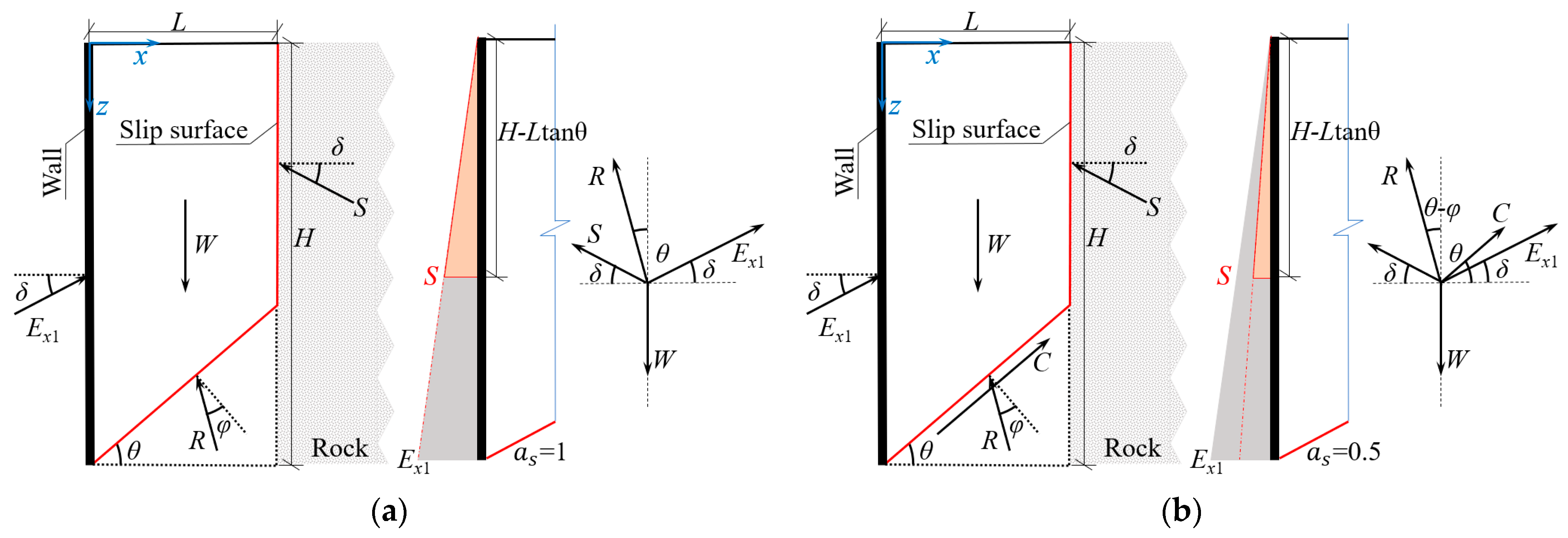
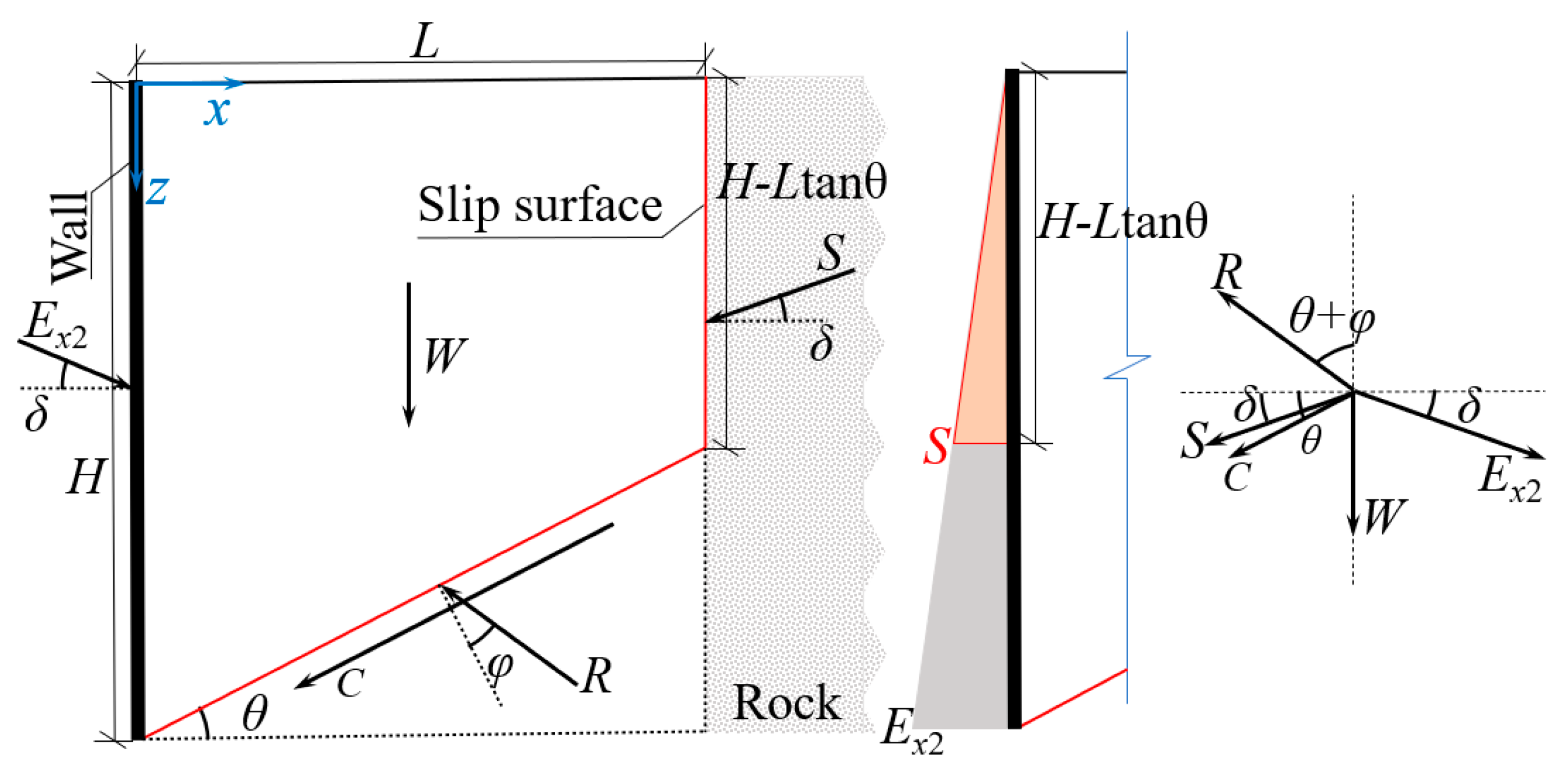
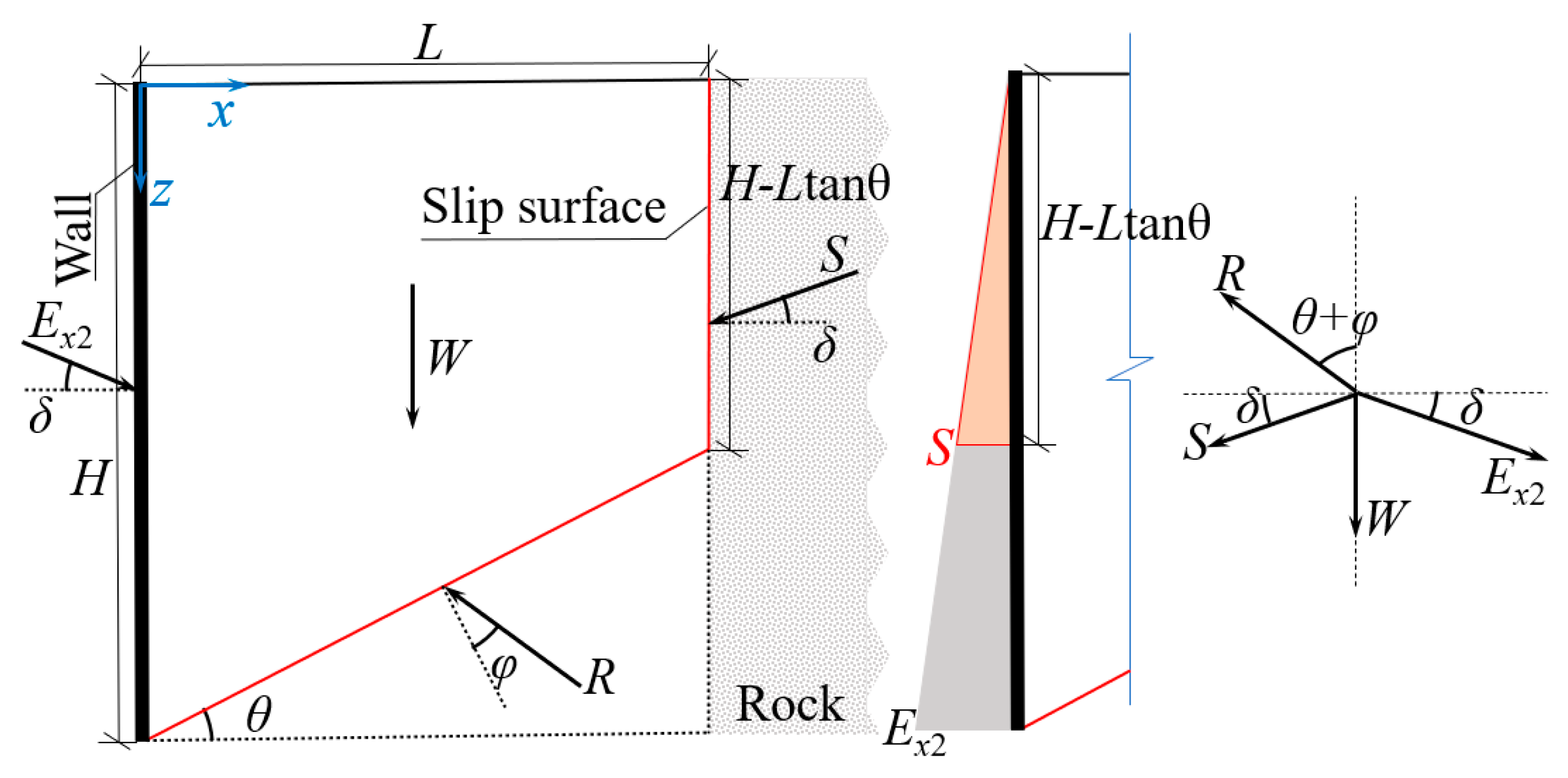
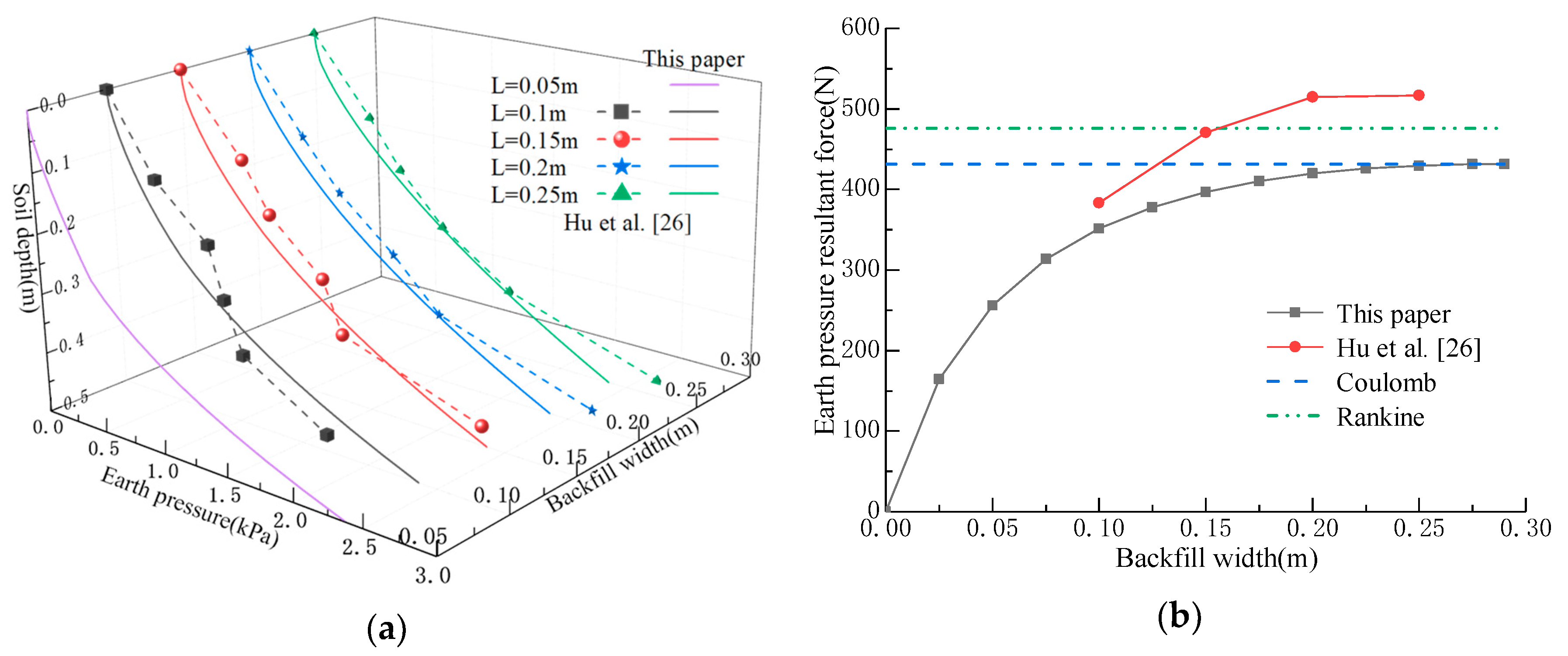

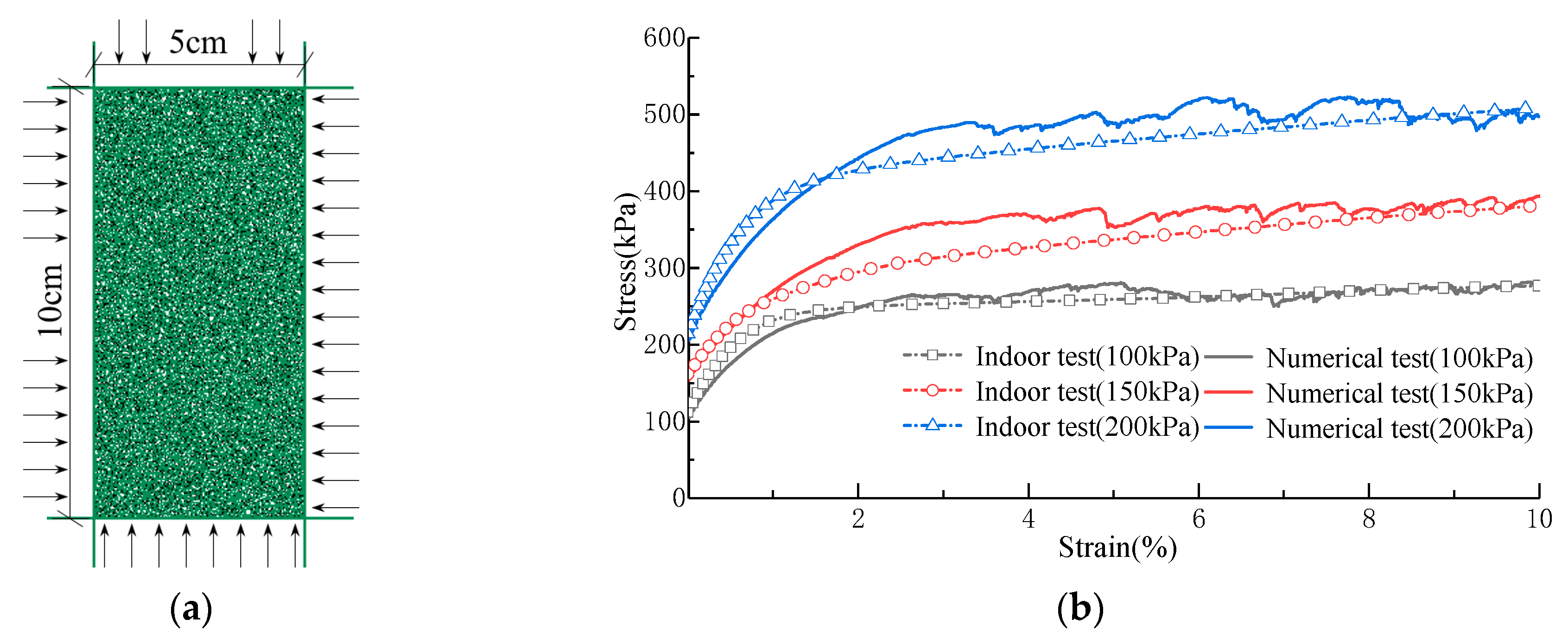
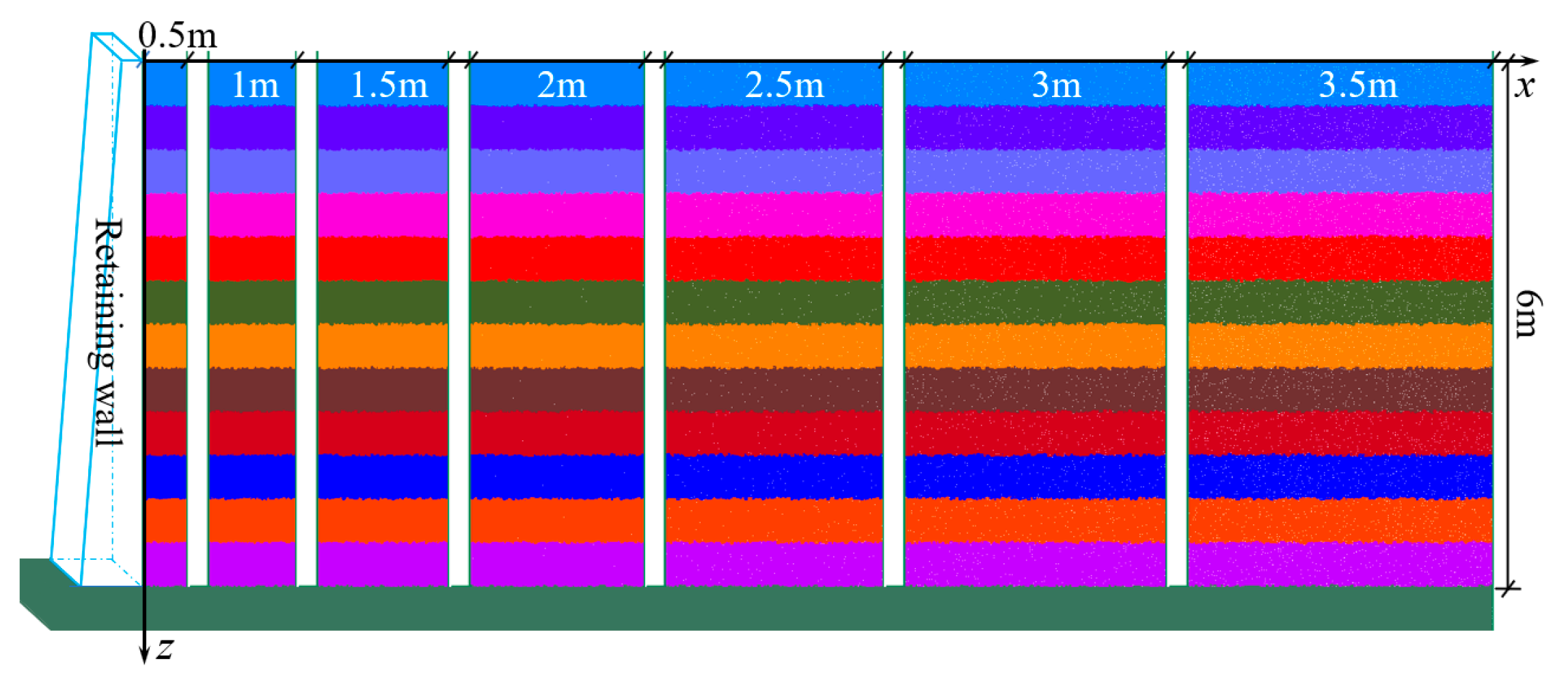



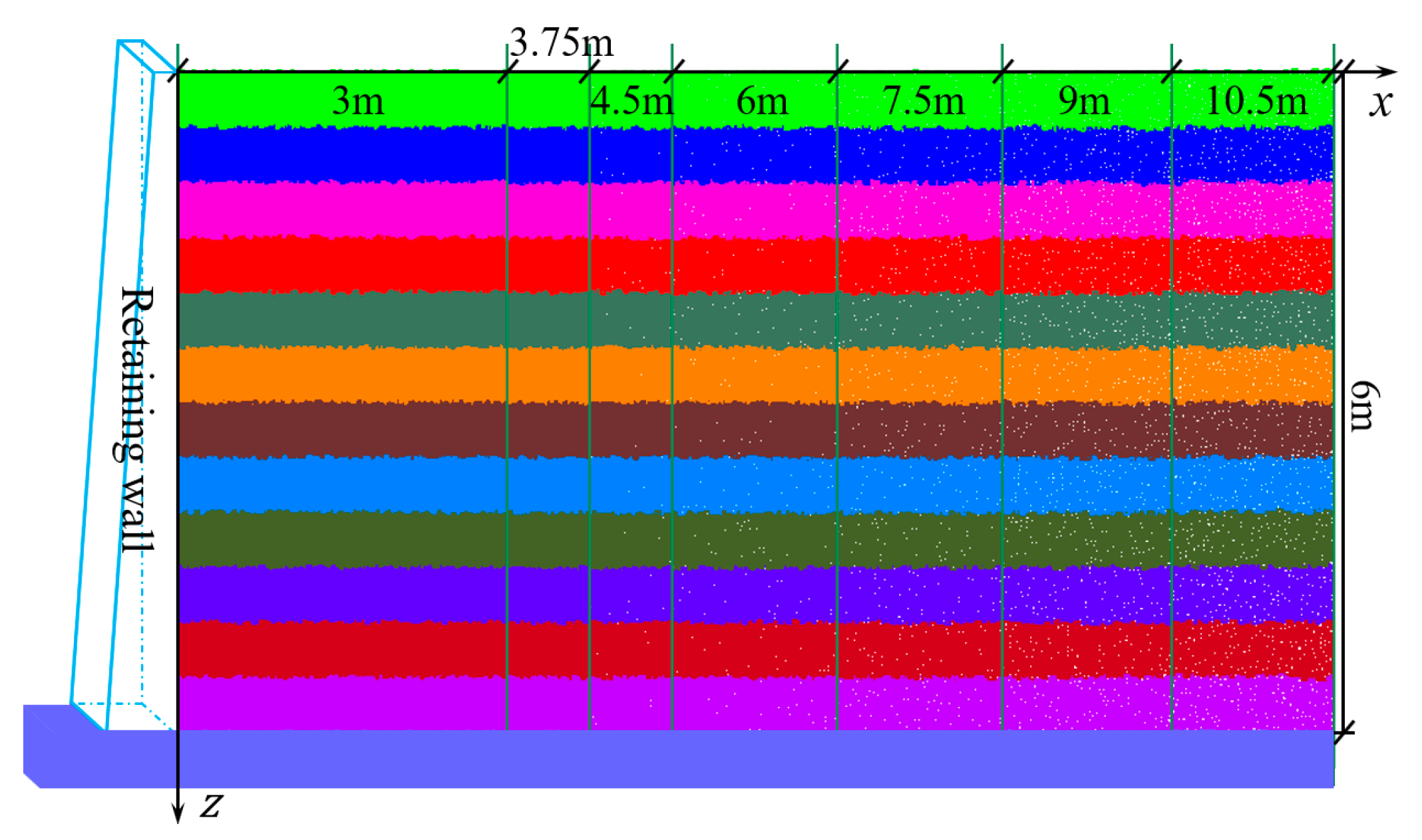

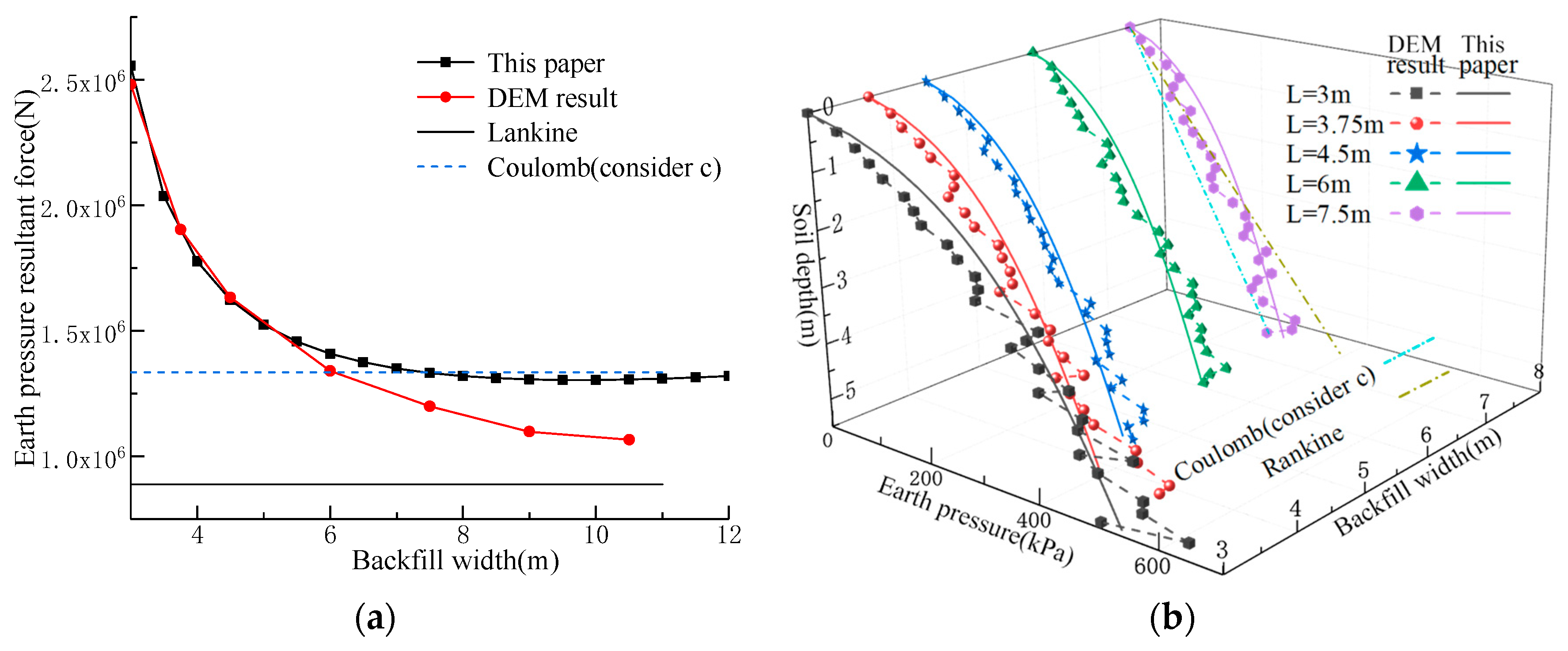
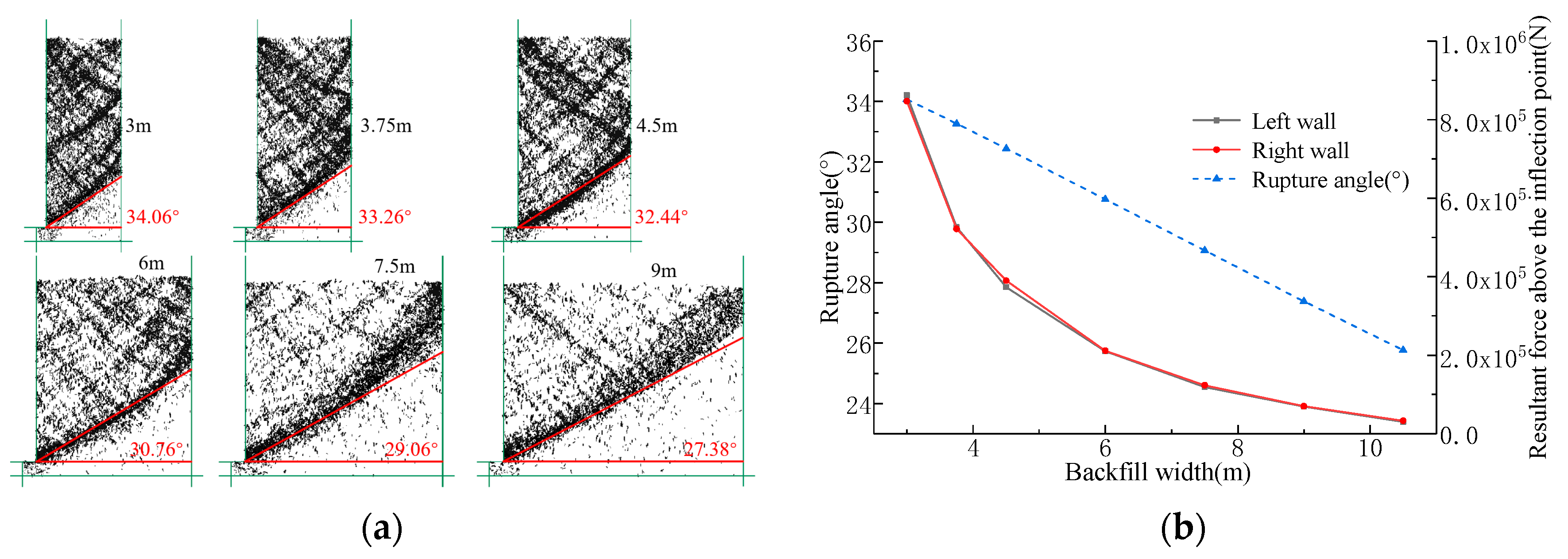
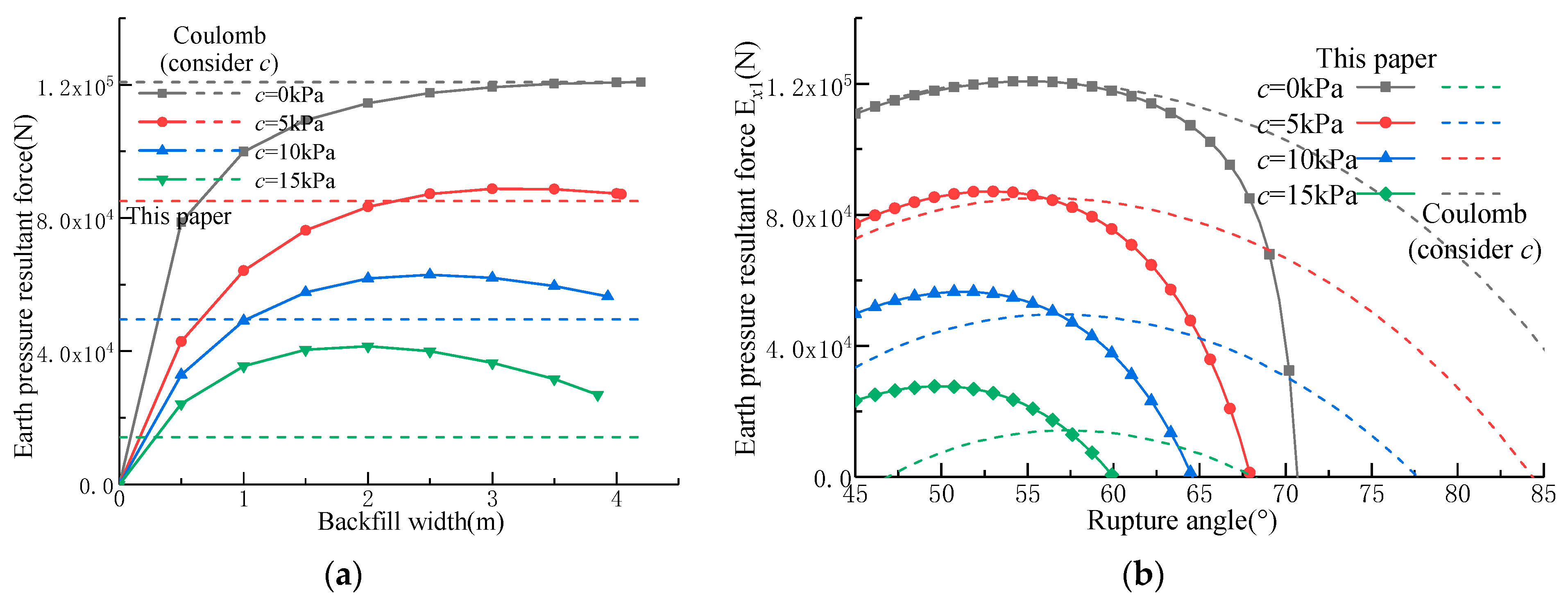



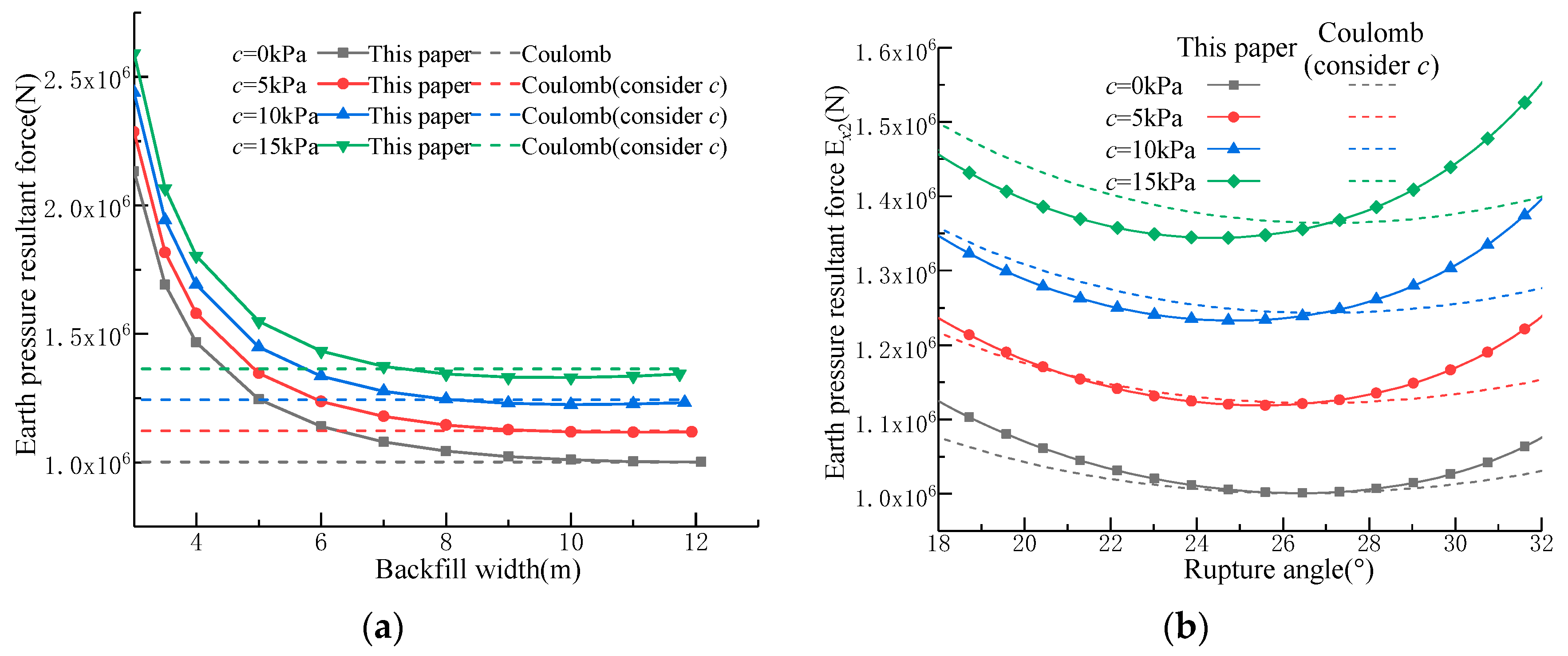


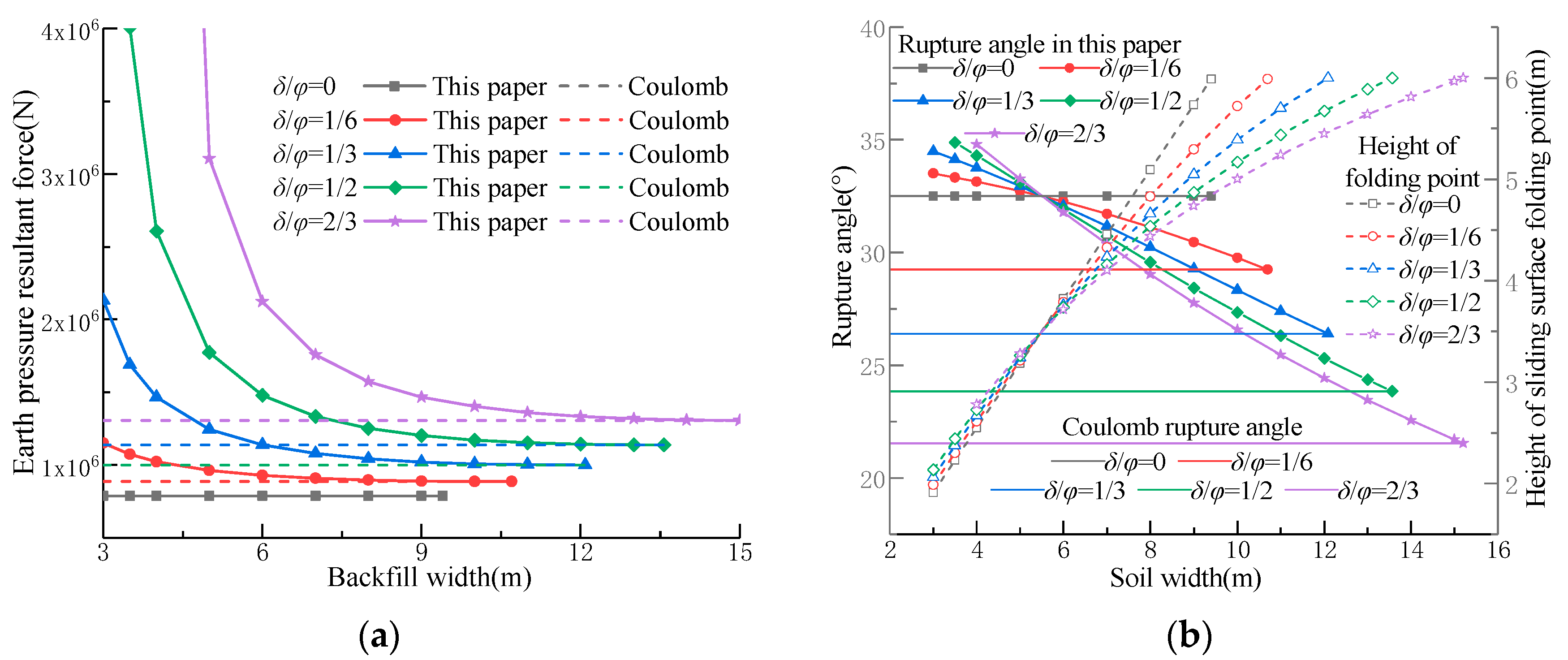
| (g/cm3) | Density (g/cm3) | Void Ratio | /kPa | /° |
|---|---|---|---|---|
| 2.7 | 1.78 | 0.808 | 14 | 24.6 |
| Particle Density (kg/m3) | Grain Size (mm) | (MPa) | Maximum Attractive Force (N) | Attraction Range (mm) | |||
|---|---|---|---|---|---|---|---|
| 2650 | 0.71~0.18 | 35 | 3.6 | 0.21 | 0.8 | 10 | 0.35 |
Disclaimer/Publisher’s Note: The statements, opinions and data contained in all publications are solely those of the individual author(s) and contributor(s) and not of MDPI and/or the editor(s). MDPI and/or the editor(s) disclaim responsibility for any injury to people or property resulting from any ideas, methods, instructions or products referred to in the content. |
© 2025 by the authors. Licensee MDPI, Basel, Switzerland. This article is an open access article distributed under the terms and conditions of the Creative Commons Attribution (CC BY) license (https://creativecommons.org/licenses/by/4.0/).
Share and Cite
Wang, X.; Dang, F.; Cao, X.; Zhang, L.; Gao, J.; Xue, H. Solution for Active and Passive Earth Pressure on Rigid Retaining Walls with Narrow Backfill. Appl. Sci. 2025, 15, 1750. https://doi.org/10.3390/app15041750
Wang X, Dang F, Cao X, Zhang L, Gao J, Xue H. Solution for Active and Passive Earth Pressure on Rigid Retaining Walls with Narrow Backfill. Applied Sciences. 2025; 15(4):1750. https://doi.org/10.3390/app15041750
Chicago/Turabian StyleWang, Xu, Faning Dang, Xiaoshan Cao, Le Zhang, Jun Gao, and Haibin Xue. 2025. "Solution for Active and Passive Earth Pressure on Rigid Retaining Walls with Narrow Backfill" Applied Sciences 15, no. 4: 1750. https://doi.org/10.3390/app15041750
APA StyleWang, X., Dang, F., Cao, X., Zhang, L., Gao, J., & Xue, H. (2025). Solution for Active and Passive Earth Pressure on Rigid Retaining Walls with Narrow Backfill. Applied Sciences, 15(4), 1750. https://doi.org/10.3390/app15041750






